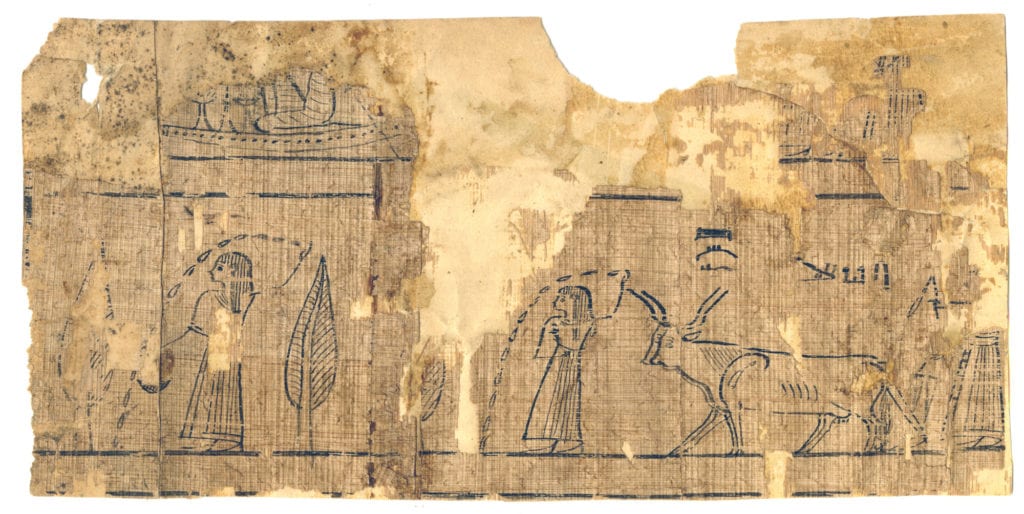
This new volume of the Joseph Smith Papers is another Facsimile Edition, which means it is an oversized volume (approx. 12 1/4 x 9 1/2 inches, matching the other Facsimile Editions in the series) with all of the items related to the Book of Abraham available to the public for the first time in full color. It contains photos of the extant papyri, the collection of documents commonly known as the Kirtland Egyptian Papers, and the Book of Abraham as first published in the Times and Seasons, along with the printing plates that were used.
As with all the books in the JSP series, there is a great volume introduction that gives the historical background and an overview of what the volume contains. It explains how the mummies and papyri came into the possession of Joseph Smith, what the various sets of documents are and how they might relate, and how revelation and translation were understood at the time by Joseph and the Saints. This is important since it has been known since the extant fragments were recovered in the 1960s that they actually contain common funerary texts (see https://archive.org/stream/improvementera7101unse#page/n13/mode/2up). There are two theories that explain this discrepancy – either the scriptural text was on the much larger portion of papyri that was lost, or it was revealed without regard to what the papyri actually contain (see https://www.lds.org/topics/translation-and-historicity-of-the-book-of-abraham?lang=eng) – the introduction focuses on the latter.

There is also a brief introduction to each section, explaining what it contains and the related history, along with a physical description of the items, including measurements (this is particularly important because the photos are not to scale, although there are 2 pages that do show fragments of the Book of Breathing and the Book of the Dead in relationship with each other). At the end is a reference material section, which contains a “Book of Abraham Chronology for the Years 1835 and 184s,” “Works Cited,” and “Comparison of Characters.” This last item is a chart spanning 30 pages which “allows readers to compare the instances of a character and its associated information across all the documents in which that character appears” (page 350.) This chart is likely to be a helpful resource used in future research.
The documents are available online now, but the “Comparison of Characters,” volume introduction, and the notes are currently only available in the book. And, as always, the notes contain very helpful and interesting information. It is evident that a lot of time was spent in careful studying of the documents to produce the notes.

The first part of the book, with the Egyptian papyri, speaks of them as an Egyptologist would view and translate them today. The remainder of the book speaks of the documents produced by Joseph Smith and his associates as they saw them, and tries to make sense of what they might have been doing, as they appear to have either been “study[ing] it out in [their] mind[s]” (see D&C 9:7-8) before and during the translation, which is the approach this book takes, or trying to reverse engineer the translation after it was done (another common theory).
This volume does have a number of flaws, such as the image on page 47 being upside down, and there is already an errata page online that lists some of them. But it was quite an ambitious endeavor that many of us never expected to see in print. For anyone interested in the study of the Book of Abraham beyond the scriptural text, this volume is a must have.
Related Resources:
The Joseph Smith Papers: Book of Abraham and Other Egyptian Material
The Joseph Smith Papers: The Book of Abraham and the Joseph Smith Papers (YouTube video)
The Joseph Smith Papers: The Story of the Joseph Smith Papyri (YouTube video)
The Joseph Smith Papers: Book of Abraham Artifact Tour (YouTube video)
lds.org: Gospel Topics Essay: Translation and Historicity of the Book of Abraham
lds.org: December, 2018 Ensign: The Book of Abraham, Revelation, and You
BYU Religious Studies Center: Teaching the Book of Abraham Facsimiles
FairMormon Blog: Book Review: An Introduction to the Book of Abraham
FairMormon Blog: Egyptology and the Book of Abraham: An Interview with Egyptologist Kerry Muhlestein
2014 FairMormon Conference: The Book of Abraham and Unnoticed Assumptions
2012 FairMormon Conference: Book of Abraham, I Presume
2010 FairMormon Conference: Marginal Characters in the Book of Abraham Manuscripts
2010 FairMormon Conference: The Meaning of the Kirtland Egyptian Papers Part I
2010 FairMormon Conference: The Meaning of the Kirtland Egyptian Papers Part II
FairMormon Answers: Book of Abraham
The post Book Review: Joseph Smith Papers, Revelations and Translations, Vol. 4: Book of Abraham and Related Manuscripts appeared first on FairMormon.
Continue reading at the original source →



